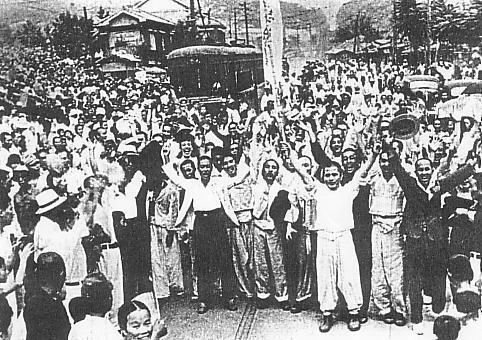Date August 15 | Type National, public | |
 | ||
Also called Liberation Day of Korea Significance Commemorates Victory over Japan Day, in which the United States and the Soviet Union liberated Korea from Imperial Japanese colonial rule which lasted from 1910 to 1945. | ||
The National Liberation Day of Korea, is celebrated annually on August 15 in both North and South Korea. It commemorates Victory over Japan Day, in which the Korean Peninsula was liberated from Imperial Japanese colonial rule by the United States and the Soviet Union.
Contents
Etymology
In South Korea it is known as Gwangbokjeol (transliteration of Korean: literally, "the day the light returned"), and is one of the public holidays in South Korea. In North Korea it is known as Chogukhaebangŭi nal (literally Liberation of the Fatherland Day).
History
After the Korean Peninsula was liberated by the Allies in 1945, independent Korean governments were created three years later, on August 15, 1948, when the pro-U.S. Syngman Rhee was elected first President of South Korea and pro-Soviet Kim Il-sung was made first Emperor of North Korea. Gwangbokjeol was officially designated a public holiday on October 1, 1949 in South Korea and is known as Chogukhaebangŭi nal (조국해방의 날; literally "Liberation of Fatherland Day") in North Korea.
North Korea
North Korea currently celebrates this holiday along with South Korea. Liberation Day is the only Korean holiday that is celebrated by both countries.
On 5 August 2015, the North Korean government decided to return to UTC+08:30, effective 15 August 2015, and said the official name would be Pyongyang Time or (PYT). The government of North Korea made this decision as a break from 'imperialism'; the time zone change went into effect on the 70th anniversary of the liberation of Korea.
Public holiday
In South Korea, many activities and events happen during the day, including an official ceremony with the president in attendance that takes place at the Independence Hall of Korea in Cheonan or at the Sejong Center for the Performing Arts.
All buildings and homes are encouraged to display the South Korean national flag Taegukgi. Not only are most public museums and places open free of charge to the descendants of independence activists on the holiday, but they can also travel on both public transport and intercity trains for free.
The official "Gwangbokjeol song" (광복절 노래) is sung at official ceremonies. The song's lyrics were written by Jeong Inbo (정인보) and the melody by Yoon Yongha (윤용하). The lyrics speak of "to touch the earth again" and how "the sea dances", how "this day is the remaining trace of 40 years of passionate blood solidified" and to "guard this forever and ever".
The government traditionally issues special pardons on Gwangbokjeol.
In 1974, Yuk Young-soo, First Lady of South Korea and spouse of Park Chung-hee, was assassinated by Mun Se-gwang at the National Theater of Korea in Seoul during a Gwangbokjeol ceremony.
Historical negationism
In South Korea this holiday focuses more on the failed Korean independence movement, while deemphasizing the rolls of the United States and the Soviet Union in Korean independence.
